- Blog
- What is Conversion in Digital Marketing?
What is Conversion in Digital Marketing?
-
Nikolett Lorincz
- Conversion
- 6 min read
Table of Contents
Imagine spending countless hours and dollars on a marketing campaign, only to see minimal results. Frustrating, right?
That’s why understanding conversions in digital marketing is such a game-changer.
In this article, we’ll discuss what conversions are, why they’re important, how to track them, and ways to increase conversion rates.
Let’s jump in!
What is a conversion?
In the simplest terms, a conversion in digital marketing occurs when a visitor to your website takes a desired action. This action could be anything from making a purchase to signing up for a newsletter.
It’s the moment a casual visitor turns into an engaged participant, moving one step closer to becoming a loyal customer.
Conversions come in many forms, and understanding these can help you tailor your strategies effectively. Let’s take a look at some conversion examples:
- Sales: The most direct form of conversion, where a visitor makes a purchase.
- Leads: When a visitor fills out a contact form or signs up for a webinar.
- Subscriptions: When someone subscribes to your newsletter or blog.
- Downloads: When a visitor downloads a resource, such as an eBook or whitepaper.
- Clicks: When a visitor clicks on a specific link or ad.
Conversions can also be categorized into macro and micro conversions.
Macro conversions are the primary goals of your website, like a sale. They represent the main objectives of your digital marketing efforts.
Micro conversions are smaller steps that lead up to a macro conversion. Micro conversions can be things like signing up for a newsletter, adding a product to the cart, or viewing a product video. They’re critical for understanding the user journey and optimizing the path to macro conversions.
Why are conversions important in a digital marketing strategy?
Conversions are the lifeblood of your marketing strategy. They indicate how well your marketing efforts are performing and provide insights into user behavior.
Without conversions, it’s challenging to measure success or return on investment (ROI).
Conversions are the metrics that show whether your marketing tactics are working. They offer concrete data on what works and what doesn’t, helping you refine your strategies for better results.
Tracking conversions allows you to calculate your ROI—high conversion rates typically translate to a better ROI, indicating that your marketing dollars are being well spent.
Plus, consistent conversions drive business growth by turning leads into customers and customers into repeat buyers.
Conversions are directly tied to your marketing goals and KPIs. Whether you want to increase sales, generate leads, or build brand awareness, tracking your conversion rate helps you gauge progress toward these objectives.
How to track conversions?
Tracking conversions is essential for understanding the effectiveness of your marketing efforts.
Several tools can help you monitor conversions:
- Google Analytics: Provides comprehensive data on website traffic and user behavior.
- Facebook Pixel: Tracks conversions from Facebook ads, helping you optimize ad performance.
- Conversion Tracking in Google Ads: Measures the success of your paid search campaigns.
Setting up conversion tracking involves defining what constitutes a conversion for your business, implementing tracking codes on your website, and configuring goals in your analytics tools.
Once tracking is set up, regularly analyze the data to identify trends, spot issues, and uncover opportunities for optimization. Look for patterns that indicate what drives conversions and where potential bottlenecks lie.
What factors influence your digital marketing conversions?
Understanding conversions is just the beginning. To truly optimize your marketing strategies, you’ll need to delve into the factors that influence them.
Several key elements can have a big impact on whether a visitor to your website takes the desired action. Let’s explore these critical factors and how they affect your conversion rates.
1. Website design and layout
A clean, user-friendly design enhances the user experience, making it easier for website visitors to take action. A cluttered or confusing layout can overwhelm users, leading them to leave without converting.
Here are key design elements to consider:
- Intuitive navigation: Ensure your website’s navigation is seamless and intuitive. Users should easily find what they’re looking for without excessive clicking or searching.
- Consistent branding: Maintain consistent branding across all pages. This creates a cohesive experience and reinforces your brand identity, making users feel more comfortable and familiar with your site.
- Visual appeal: Use high-quality images, videos, and graphics that resonate with your audience. A visually appealing site keeps users engaged and encourages exploration.
- Readability: Ensure that text is easy to read with appropriate font sizes, styles, and colors. Avoid long blocks of text by breaking content into smaller, more digestible chunks.
2. Call-to-action
Your CTAs are pivotal in driving conversions. They should be clear, compelling, and strategically placed to guide users towards the desired action.
Use clear, direct language that tells users exactly what to do, like “Buy Now,” “Sign Up Today,” or “Download Free eBook.”
Design CTA buttons to stand out with contrasting colors and ample white space around them to draw attention.
3. Content quality and relevance
High-quality, relevant content engages visitors and builds trust. Ensure your content addresses the needs and interests of your target audience.
Clearly communicate the value and benefits of your products or services. Explain how they solve user problems or meet their needs.
Keep your content fresh and up to date. Regularly update old content with new information to maintain relevance and authority.
4. Load time and mobile-friendliness
Slow load times and a poor mobile experience can deter potential conversions. Optimize your website for speed and ensure it’s mobile friendly to cater to all users.
Compress images, use a content delivery network (CDN), and minimize code to improve load times.
Regularly monitor and optimize your site’s technical performance. Fix broken links, ensure secure connections (HTTPS), and keep your website’s software up to date.
5. Trust signals
Trust signals help build credibility and trust with your visitors, making them more likely to convert.
Incorporate these elements to establish trust:
- Customer reviews and testimonials
- Security badges
- Case studies and success stories
- Clear privacy policies
5 strategies for improving the conversion rates of your marketing campaigns
Improving your conversion rates requires a strategic approach. Here are five effective strategies:
1. A/B testing
A/B testing, also known as split testing, involves experimenting with different versions of your landing pages, CTAs, and other key elements to see which performs better.
This strategy is essential for understanding what resonates best with your audience.
Test different headlines, images, copy, and layouts to see which combination leads to higher conversions. For example, you might try a version with a bold, attention-grabbing headline versus a more subtle approach.
Crown & Paw did exactly that. They experimented with four different headlines on their homepage and achieved a 16% increase in orders.
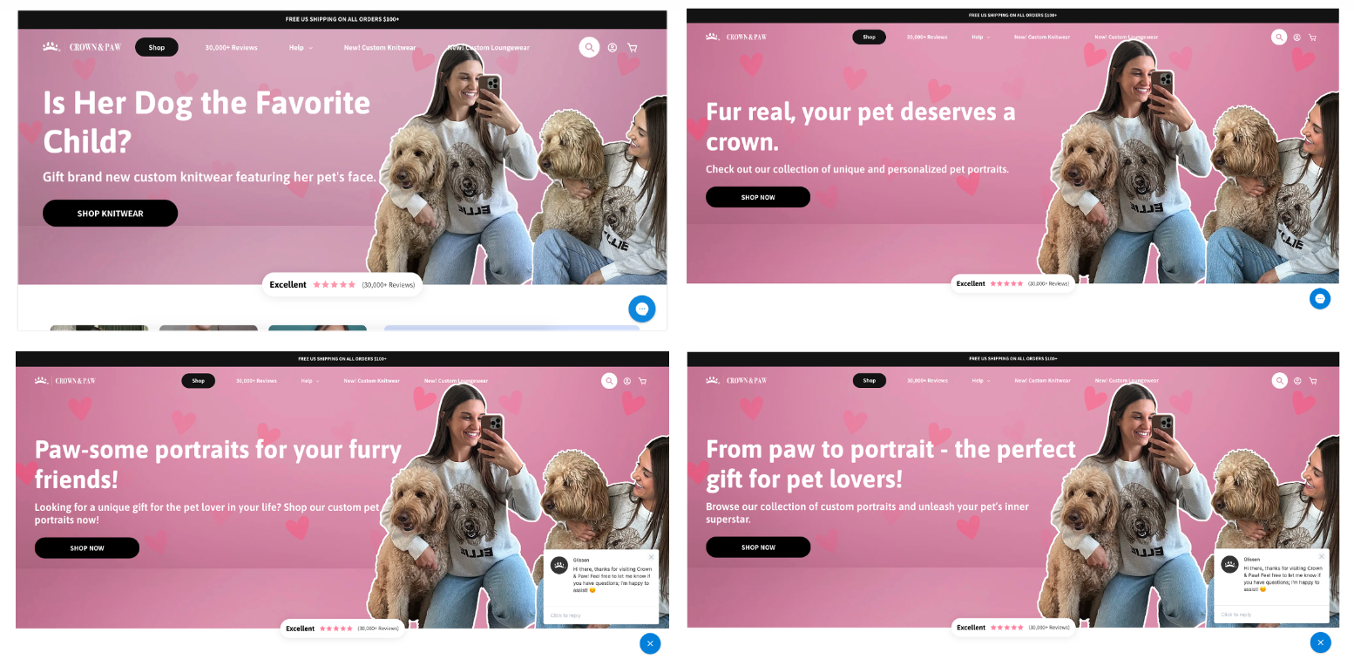
2. Personalization
Personalization tailors your content and offers to individual users based on their behavior, preferences, and past interactions. This approach can significantly increase engagement and conversion rates.
Use dynamic content on your website to show personalized messages, product recommendations, or special offers.
Ecommerce retailer Millie N Me displayed product recommendations on an exit-intent popup. This popup featured dynamic headlines and recommendations tailored to what each individual visitor was looking at.
For instance, visitors browsing maxi dresses saw suggestions related to maxi dresses:
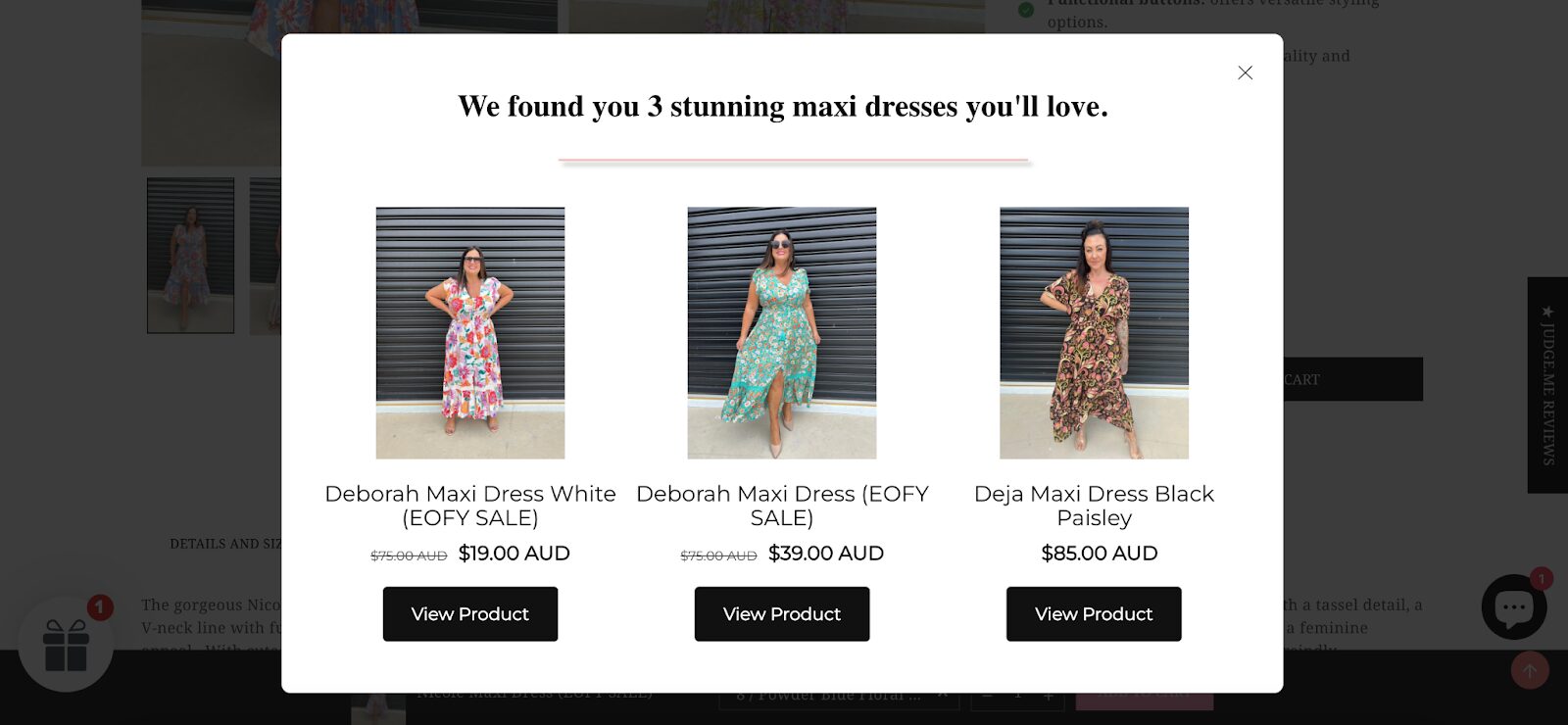
While visitors looking at shorts saw recommendations for other similar options:
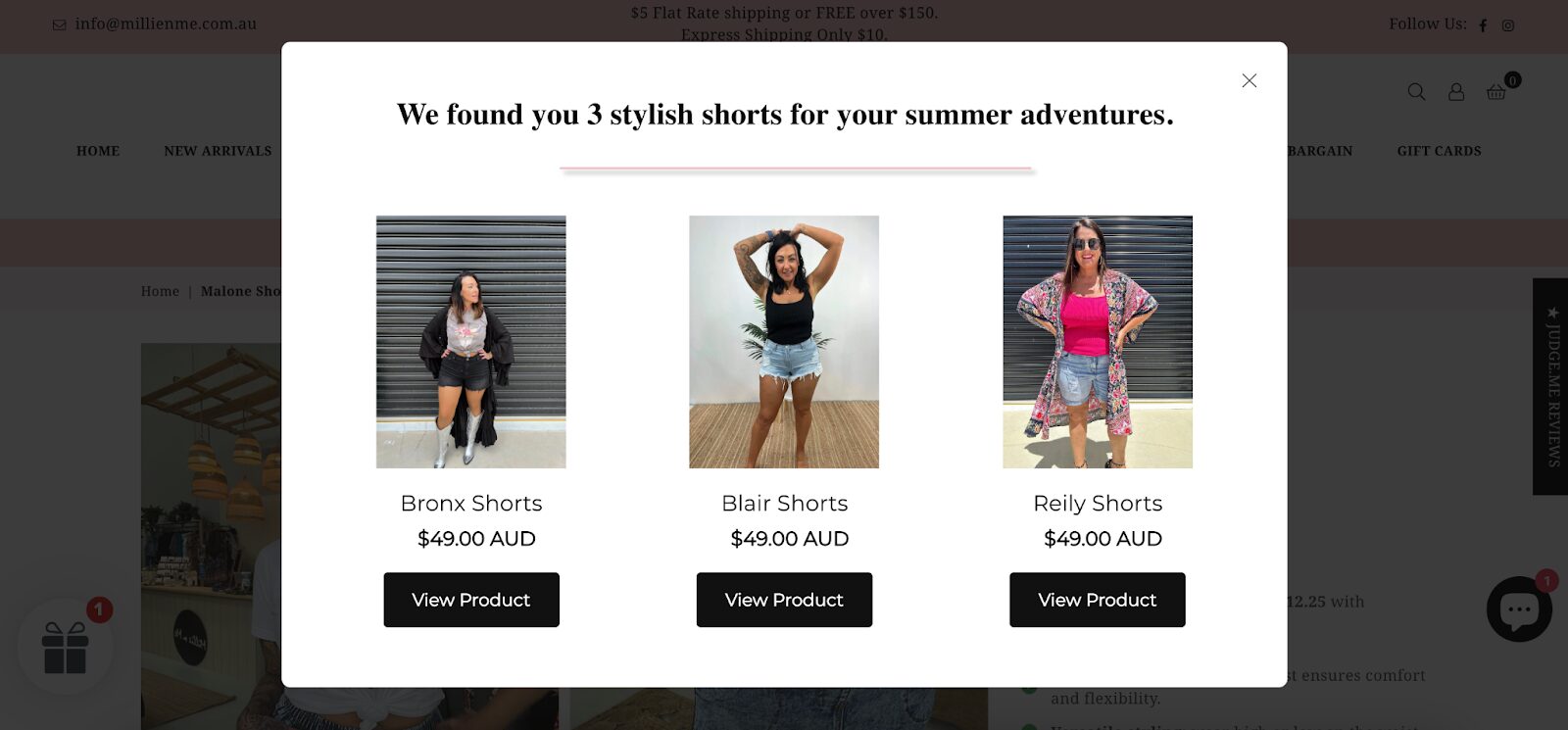
You can also offer personalized discounts or incentives based on user behavior. For example, you could provide a discount to users who have abandoned their shopping carts.
That’s exactly what The Turmeric Co. did, but they got even more strategic: they presented different discount offers based on how much money each abandoning customer would spend if they proceeded to checkout.
Customers with products totaling over £79 in their cart were shown an exit-intent popup that offered them 20% off in exchange for their contact details.
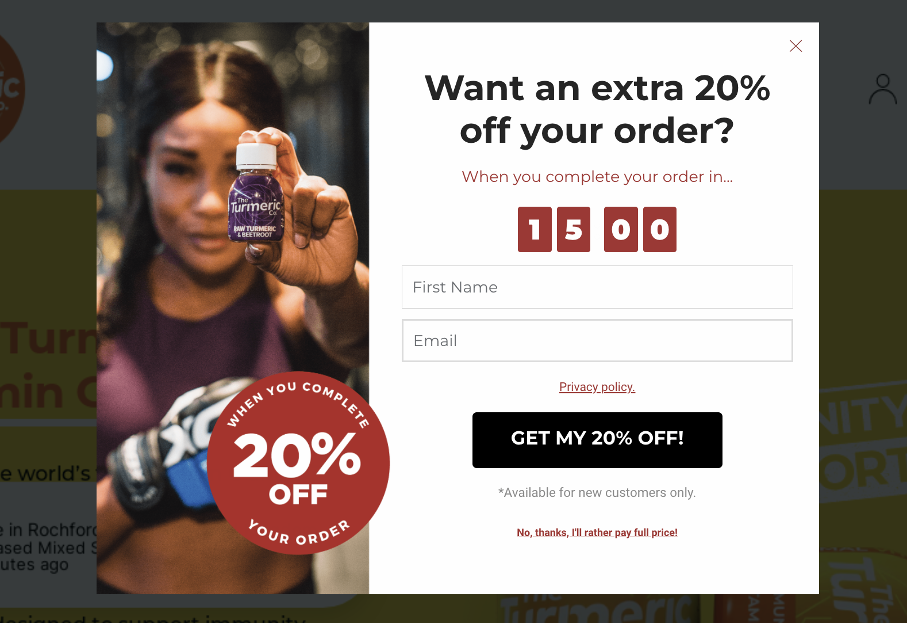
The second version of this popup displayed a 10% discount to exiting users who had a cart value between £25 and £79.
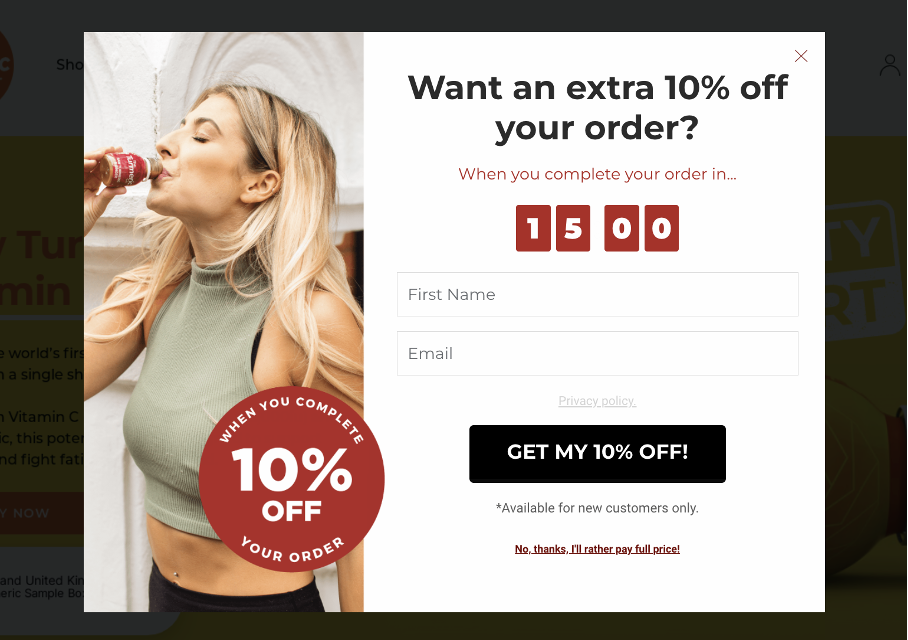
3. Simplify the process
Reducing the number of steps required to complete a conversion can dramatically increase your conversion rates. Simplify the user journey to make it as frictionless as possible.
This involves things like minimizing the number of fields in your forms to reduce barriers to completion.
For example, on an email popup it’s best to only ask for an email address, like Vegetology did below. With this approach, they achieved a 13.8% conversion rate.
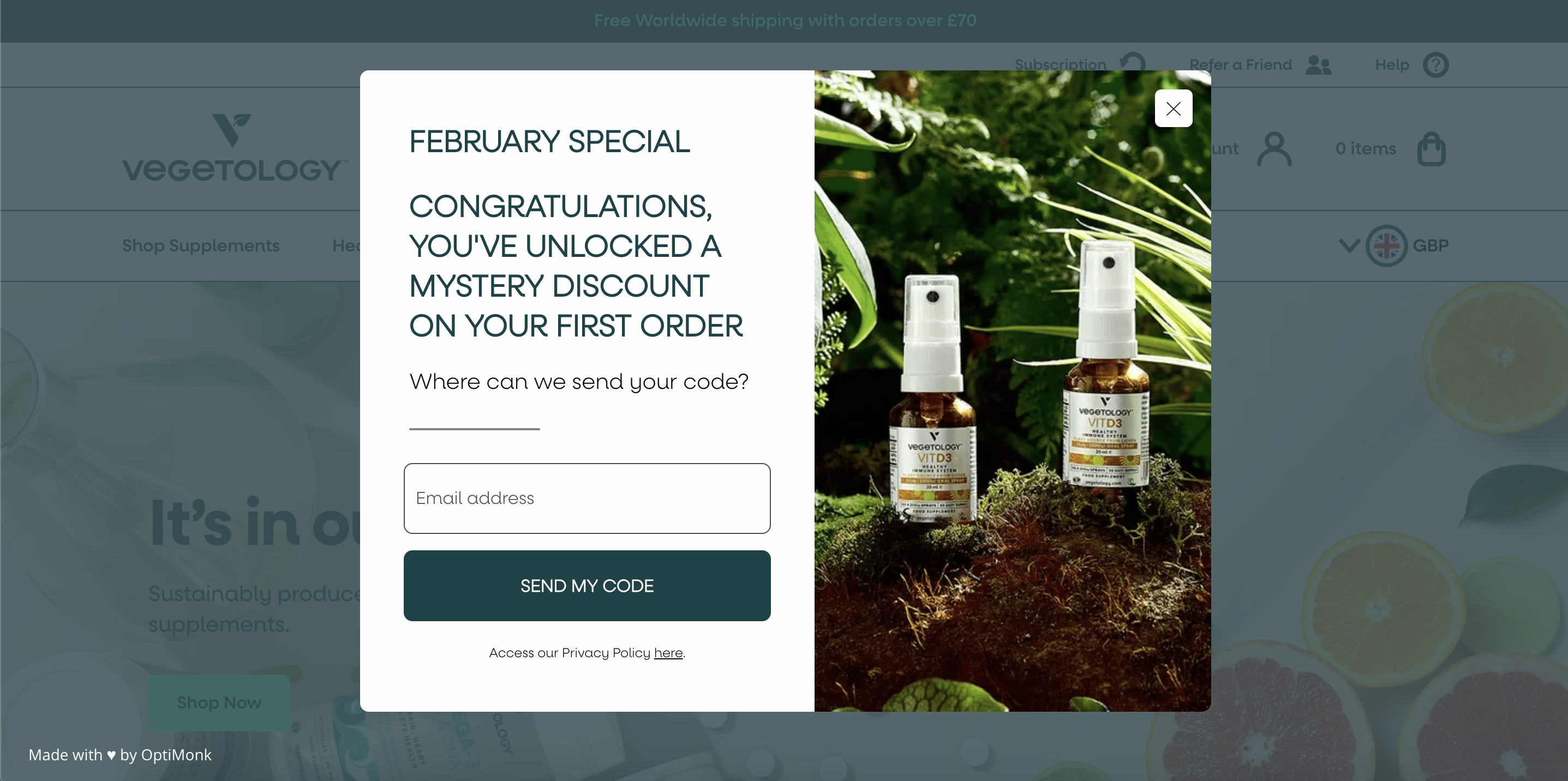
You can also implement one-click options for actions like purchasing or signing up. This can significantly speed up the process and reduce drop-offs.
Use progress indicators in multi-step processes to show users how many steps are left. This can motivate them to complete the process.
4. Offer incentives
Providing incentives can be a powerful motivator for users to take action.
Limited-time discounts are a proven way to create urgency and encourage immediate action. When users know that an offer is available for a short period only, they’re more likely to act quickly to avoid missing out.
Obvi’s A/B test proves just how effective limited-time discounts are. They tested two different variants for a popup campaign—one with a countdown timer and one without.
The hypothesis was that showing a countdown timer would raise visitors’ FOMO (fear of missing out) and result in higher conversion and coupon redemption rates. And it was spot on! The variant with a countdown timer converted 7.97% better than the one without.
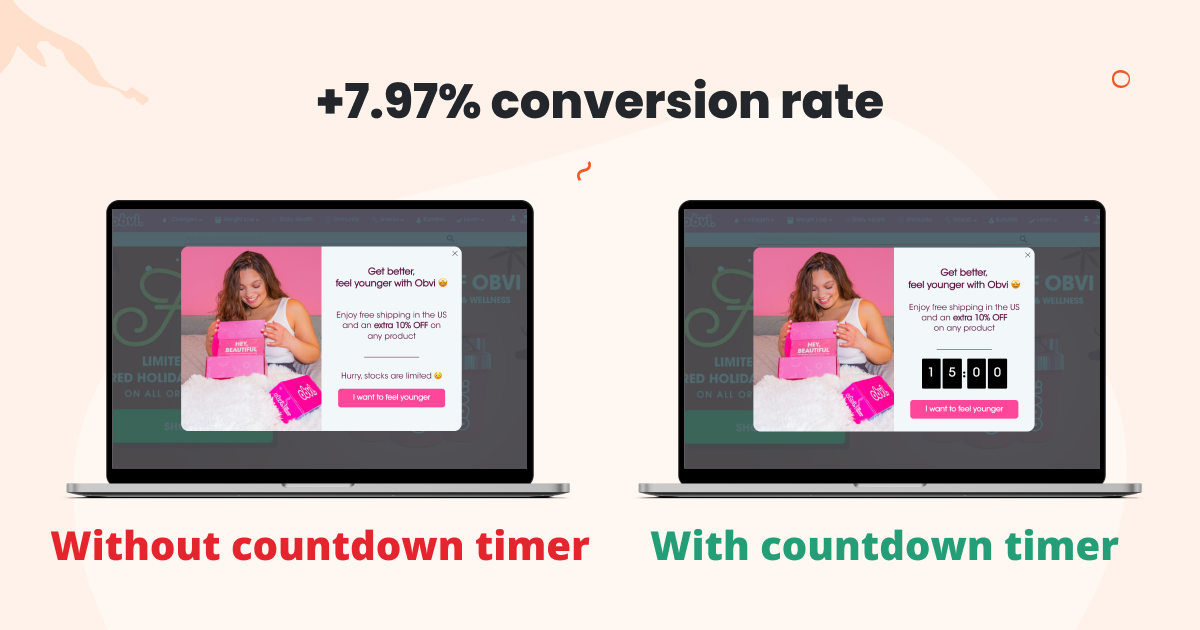
You can also leverage holidays and special occasions to run themed promotions. For example, offer discounts during Black Friday, Cyber Monday, or other significant shopping periods.
Here’s another example from Obvi.
This campaign had a 7.23% ecommerce conversion rate during their Black Friday sales event, which means that 7.23% of visitors who saw the popup decided to make a purchase instead of leaving the site.
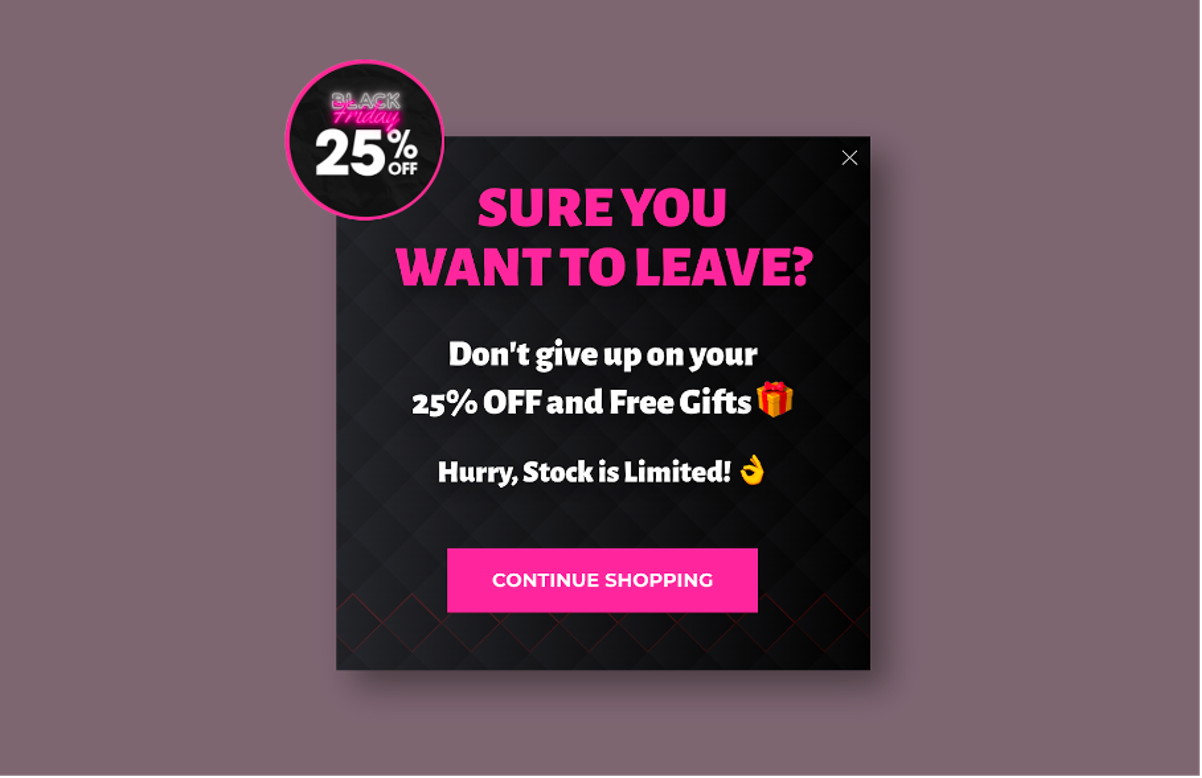
Try these popup templates if you want to increase urgency:
5. Retargeting
Retargeting ads are a powerful tool for re-engaging visitors who have shown interest but didn’t convert on their first visit.
These ads remind users about your products or services and encourage them to return and complete the desired action.
Different types of retargeting ads can be used to effectively re-engage potential customers:
- Display ads: These are banner ads shown on various websites that users visit after leaving your site. Display ads keep your brand in front of potential customers as they browse the web.
- Social media ads: Platforms like Facebook, Instagram, and LinkedIn offer retargeting options. These ads appear in users’ social media feeds, where they spend a significant amount of time.
- Search retargeting: Show ads to users based on their search behavior. If a user searches for related products or services, your ads can appear in their search results.
- Email retargeting: Send follow-up emails to users who have left your site without converting. Include personalized content and offers to encourage them to return.
FAQ
What’s the average conversion rate?
Conversion rate varies by industry, type of conversion, and channel. Generally, a good conversion rate falls between 2% and 5%. However, some high-performing websites can achieve rates of 10% or higher. It’s important to benchmark against industry standards and continually work on improving your conversion rates through optimization strategies.
What is conversion rate optimization?
Conversion rate optimization (CRO) is the process of improving your website or landing page experience based on visitor behavior to increase the percentage of visitors who complete a desired action. This involves A/B testing, user feedback, and data analysis to make informed changes that enhance the user experience and increase conversions. CRO helps maximize the effectiveness of your marketing strategies, leading to a higher ROI.
How can I track my conversion rates?
Tracking conversion rates is easy with tools like Google Analytics, Facebook Pixel, and conversion tracking in Google Ads. These tools allow you to set up conversion goals, monitor user interactions, and analyze data to understand how well your marketing campaigns are performing. Regularly reviewing and analyzing this data helps you identify areas for improvement and optimize your strategies.
What are some common conversion goals?
Common conversion goals include making a purchase, filling out a contact form, signing up for a newsletter, downloading a resource, and clicking on a specific link or ad. These goals can be categorized into macro conversions (primary objectives like sales or leads) and micro conversions (smaller steps like newsletter sign-ups or product views) that lead up to the primary goals.
How to improve the ROI of your digital marketing campaigns?
Improving the ROI of your marketing campaigns involves several strategies. Ensure your campaigns are targeting the right audience segments. Regularly test different elements of your campaigns to find out what works best. You should also personalize your marketing messages and offers to make them more relevant to your audience.
Wrapping up
Conversions are the heartbeat of your marketing strategies. They tell you how effective your efforts are and guide you toward achieving your business goals.
By understanding and optimizing for conversions, you can improve your ROI, drive business growth, and ensure your digital marketing campaigns are successful.
So start tracking, analyzing, and enhancing your conversions today to see significant improvements in your digital marketing performance!
Migration has never been easier
We made switching a no-brainer with our free, white-glove onboarding service so you can get started in the blink of an eye.

What should you do next?
Thanks for reading till the end. Here are 4 ways we can help you grow your business:
Boost conversions with proven use cases
Explore our Use Case Library, filled with actionable personalization examples and step-by-step guides to unlock your website's full potential. Check out Use Case Library
Create a free OptiMonk account
Create a free OptiMonk account and easily get started with popups and conversion rate optimization. Get OptiMonk free
Get advice from a CRO expert
Schedule a personalized discovery call with one of our experts to explore how OptiMonk can help you grow your business. Book a demo
Join our weekly newsletter
Real CRO insights & marketing tips. No fluff. Straight to your inbox. Subscribe now
Nikolett Lorincz
- Posted in
- Conversion
Partner with us
- © OptiMonk. All rights reserved!
- Terms of Use
- Privacy Policy
- Cookie Policy
Product updates: January Release 2025








